Semi-trailer

_with_EU-trailer._25.25_meters.jpg)
A semi-trailer (British English) or semitrailer (American English) is a trailer without a front axle. In the US, the term is also used to refer to the combination of a truck and a semi-trailer, a tractor-trailer.[1]
A large proportion of a semitrailer's weight is supported by a tractor unit, or a detachable front-axle assembly known as a dolly, or the tail of another trailer. A semi-trailer is normally equipped with landing gear (legs which can be lowered) to support it when it is uncoupled. Many semi-trailers have wheels that are capable of being totally dismounted and are also relocatable[2] (repositionable) to better distribute load to bearing wheel weight factors.[3] Semi-trailers are more popular for transport than full trailers, which have both front and rear axles. Ease of backing is cited as one of the semi's chief advantages. A road tractor coupled to a semi-trailer is often called a semi-trailer truck or "semi" in North America & Australia, and an articulated lorry or "artic" in the UK.
Semi-trailers with two trailer units are called B-doubles (Australian English) or tandem tractor trailers,[4] tandem rigs, or doubles (American English). Other terms used are "B-train" or (when there are three or more trailers) "road train". A B-double consists of a prime mover towing two semi-trailers, where the first semi-trailer is connected to the prime mover by a fifth wheel coupling (aka 'converter dolly') and the second semi-trailer is connected to the first semi-trailer by a fifth wheel coupling. In Australian English, the tractor unit is usually referred to as a "prime-mover", and the combination of a prime-mover and trailer is known as a "semi-trailer" or "semi".
Properties
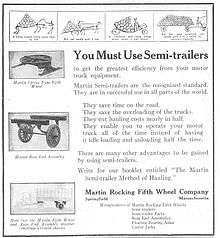
In road haulage, semi-trailers predominate over full trailers because of their flexibility. The trailers can be coupled and uncoupled quickly, allowing them to be shunted for loading and to be trunked between depots. If a power unit fails, another tractor can replace it without disturbing the cargo.
Compared with a full trailer, a semi-trailer attached to a tractor unit is easier to reverse, since it has only one turning point (the coupling), whereas a full trailer has two turning points (the coupling and the drawbar attachment). Special tractors known as shunt trucks or shuttle trucks can easily maneuver semi-trailers at a depot or loading and unloading ferries. These tractors may lift the coupling so the trailer legs clear the ground.
A rigid truck and full trailer are articulated inside the cargo area length, so a semi-trailer can have a longer continuous cargo area. Because of this, a semi-trailer can haul longer objects (logs, pipe, beams, railway track). This depends on the legislation; in some European countries, a full trailer can be as long as a semi-trailer. However, since a rigid truck is longer than a semi-tractor, this increases the overall length of the combination, making it less maneuverable.
Couplings
The two types of couplings are fifth wheel coupling and automatic. In some applications, no separable coupling is fitted, and the trailer is bolted to the tractor unit, using a bearing, and rocker feet as are used under a fifth wheel skid plate.
Fifth wheel coupling
The towing vehicle has a wide coupling plate known as a fifth wheel coupling bolted onto its chassis on which the semi-trailer rests and pivots. As the tractor reverses under the trailer, a kingpin under the front of the trailer slides into a slot in the skidplate, and the jaws of the fifth wheel close onto it. The driver has to raise the trailer legs manually, and couple the airbrake lines and electrical cables.
Automatic couplings
Many years ago, automatic couplings predominated, but are now quite rare. Automatic couplings were generally used for payloads of 12 tons or less, e.g. on the Scammell mechanical horse.
No coupling plate is used on the tractor; a turntable is permanently fixed to the underside of the trailer. This locks to the chassis of the tractor. When the tractor reverses under the trailer, its legs rise and the brake and electrical connections are made automatically. Almost the entire coupling and uncoupling procedure is operated by the driver from inside the cab, except that he or she has to descend to release (or apply) the trailer parking brake.
Types
Different types of semi-trailers are designed to haul different cargoes.
Common widths are 8 ft (2.44 m),[5] and 2.6 metres (8 ft 6.4 in) or 2.6 metres (8 ft 6 3⁄8 in).[6]
- Box or van trailers are the most common type. Standard lengths in North America are 28 ft 0 in (8.53 m), 32 ft 0 in (9.75 m), 34 ft 0 in (10.36 m), 36 ft 0 in (10.97 m), 40 ft 0 in (12.19 m), 45 ft 0 in (13.72 m), 48 ft (15 m), 53 ft 0 in (16.15 m) and 57 ft 0 in (17.37 m).[6]
- Bus-bodied trailers are hitched to a tractor unit to form a trailer bus, a simple alternative to building a rigid bus.
- Car carrier trailers carry multiple cars, usually new cars from the manufacturer. In the US and elsewhere, car carriers often carry used vehicles as well. Similar variants can carry fork lift trucks, light commercial vehicles and agricultural tractors.
- Conestoga trailers are a special form of flatbed trailer with a flexible retractable roof and siding used to carry large pieces of equipment that can only be lifted by an overhead crane, but which also need protection from the weather during transit.
- Curtain siders are similar to box trailers except the sides are movable curtains made of reinforced fabric coated with a waterproof coating. The purpose of a curtain sider is to combine the security and weather resistance of a box trailer with the ease of loading of a flatbed.
- Drop-deck trailers (or Step-frame Trailer) have a floor that drops down a level once clear of the tractor unit; the most common types of drop-deck trailers are flatbeds and curtain siders.
- Double deckers or deckers have either a fixed, hinged, or moveable second floor to enable them to carry more palletised goods. In general, a double decker can carry 40 pallets, as opposed to 26 for a standard trailer. Double deck trailers are generally a step-frame construction with the majority being either box or curtain siders, with box trailers having either a fixed or movable (floating) deck, and curtain sides having either a fixed or hinged second deck; this hinged second deck generally swings into a position down the length of the trailer, and can be divided into two or three sections to allow greater load flexibility.
- Dry bulk ("British" Powder tankers) trailers resemble big tankers, but are used for cement, sand, barite, flour, and other dry powder materials.
- Dump trailers ("British" Tippers) are trailers in which one end can be raised to allow the cargo (often building materials or Agricultural produce) to slide out the other end. Commonly, they are hinged at the rear and raised at the front, but side-unloading dump trailers also are used.
- Flatbeds consist of just a load floor and removable side rails and a bulkhead in front to protect the tractor in the event of a load shift. They can haul almost anything that can be stacked on and strapped down.
- Hopper bottoms are usually used to haul grain, but can be used to haul other materials.
- Live bottom trailers have a conveyor belt on the bottom of the trailer tub that pushes the load material out of the back of the trailer. The tub does not have to be raised to deposit the materials.
- Livestock trailers are used to haul livestock such as cattle, horses, pigs, sheep, etc. Commonly, they have two levels (or three for hogs) to maximize capacity.
- Lowboy ("British" Low-loader) trailers are a type of flatbed in which the load floor is as close to the ground as possible, most commonly used to haul heavy equipment, cranes, bulldozers, etc.
- Refrigerator trailers are box trailers with a heating/cooling unit (reefer) attached, used for hauling produce, frozen foods, meat, flowers, etc.
- Refrigerator tank trailers are well insulated or refrigerated to haul bulk liquid foods, such as liquid sugar, water, wine, milk or juices.
- Sidelifter semi-trailers have hydraulic cranes mounted at both ends of the chassis allowing for the loading and unloading of shipping containers without the need of a forklift or other container-handling equipment.
- Tank chassis trailers are used for hauling liquids such as gasoline and alcohol. some are designed with a lowered centre of gravity to ensure greater stability. Generally bottom loaded with the ability to recover any waste vapor for safety reasons.
- A "frac" tank trailer has a single and fixed axle, and is typically used during hydraulic fracturing at oil wells or for petrochemical industries. It is shaped like a wedge, and when it is unhitched, its bottom side lies flat on the ground.
- "Wing" is one of the box trailer which used in Japan. Both side panels are opened like a Gull-wing door by motor power.
Trailer types
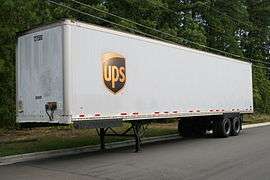 Box trailer (US)
Box trailer (US) Auto transporter (Brazil)
Auto transporter (Brazil)- Curtain sider trailer (EU)
 Semi dump trailer (Germany)
Semi dump trailer (Germany) Flatbed trailer (Iran)
Flatbed trailer (Iran)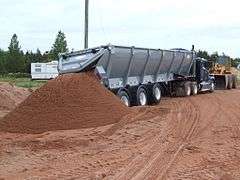 Live bottom trailer (US)
Live bottom trailer (US)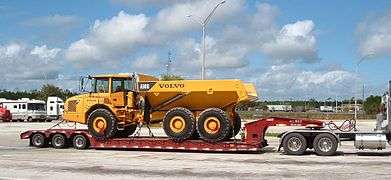 Lowboy (US)
Lowboy (US) Refrigerated trailer (UK)
Refrigerated trailer (UK) Sidelifter (New Zealand)
Sidelifter (New Zealand)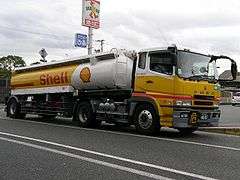 Tank trailer (Japan)
Tank trailer (Japan)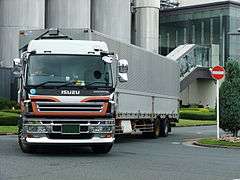 "Wing" van (Japan)
"Wing" van (Japan)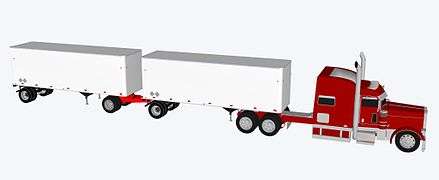 STAA double pup 28.5 foot trailers
STAA double pup 28.5 foot trailers
See also
- Air brake (road vehicle)
- Articulated vehicle
- Brake
- Cargo
- Fifth-wheel coupling
- Fruehauf Corporation
- Gladhand connector
- Globe Trailers
- Jackknifing
- Long Combination Vehicle
- Refrigerated container
- Refrigerator truck
- Semi-trailer truck
- Shunt truck
- Swap body
- Tank chassis
- Teardrop trailer (truck)
- Trailer
- Trailer skirt
- Trailer tail
- Vehicle category
References
- ↑
- ↑ http://www.bigtruckguide.com/know-how-to-slide-your-tandems/%20
- ↑ http://www.truckingtruth.com/cdl-training-program/page113
- ↑
- ↑ "Any transport transportations from the Tandem-Trans". Tandem-Trans. Retrieved 2011-01-01.
- 1 2 "Federal Size Regulations for Commercial Motor Vehicles". US Department of Transportation, Federal Highway Administration. Retrieved 2011-01-01.
External links
-
 Media related to Semi-trailers at Wikimedia Commons
Media related to Semi-trailers at Wikimedia Commons - Semi trailers' manufacturers and sellers at DMOZ